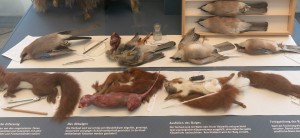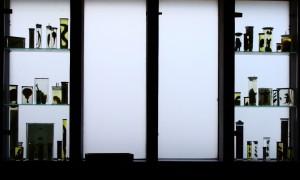The dawning of medical history museums
As science changes our relation to our bodies and our mortality there is a need for a new kind of medical history museums—a kind that challenges our senses and lets us engage in interactive exhibitions
The interest in biology is on the rise. It is no surprise that natural history museums of Europe are some of the most popular attractions for both families and adults visiting a new city. Sprung from the chaos and weirdness of 19th century cabinets of curiosity, modern museums are well-structured, beautifully designed and visitor-centered. The latest development sees a focus on the pedagogic and interactive exhibitions — here two examples:

Methods for preparation of specimens on display at Berlins museum fur Naturkunde. Photo by the author.
- Berlins Museum für Naturkunde presents a large exhibition with the various steps performed by the museums staff to preserve marine, avian and mammalian specimens.
- Copenhagen’s Zoologisk Museum hosts a “hall of bones”, which allows children to finger, touch and even play with animal skulls and bones.
Especially the last example represents a genius approach to promote science. The inquiring mood that it sets opens up new channels to understand and communicate biology.
With the interest for biology comes also a fascination for the history of medicine. In our time of molecular medicine and cyborg technology, the roots of medicine and path to our knowledge of it have become an alluring place full of mystery and superstition but also ingenious solutions. We may have forgotten it, but there was a time when an amputation kit was a well-used instrument, and could be given as a token of appreciation to a skilled medic, and when the color, taste and smell of urine was used to diagnose disease.
Many of these old procedures have, like words and traditions, left their mark. To connect to the example above, the word diabetes comes from the latin word for ’sweet’—and was originally named after the taste of these patients urine, which contains an increased level of glucose.
The next question is this: will we see medical science museums develop interactive exhibitions? With the current merge of technology with molecular medicine this represents a highly relevant area that should generate brilliant and truly educating exhibitions. Which leads directly to a discussion of the place of art in the visualization of science … but that’s a whole other post.
For the fans of Medical history
- Museum of Medical History at the Charité, Berlin bmm-charite.de
- The Wellcome Collection, London. wellcomecollection.org
- Mutter Museum, Philadelphia. collegeofphysicians.org/mutter-museum/
- The Medical History Association in south Skåne (medicinhistoriskasyd.se) hosts a tiny “Museum of Life” in Lund livetsmuseum.wordpress.com
- The dawning of medical history museums - August 12, 2014






The excellent Hagströmer Medico-Historical library can of course be added to this list.
https://hagstromerlibrary.ki.se
…and Stephen Soderbergs tv-series The Knick, about the fictional New York hospital in the early 1900.
http://www.cinemax.com/the-knick/